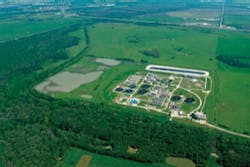Polymer Feed Pumps Help Treat Combined Sewer Overflows
By Daniel Lakovic
Massive rainwater surges have plagued the Bay View Wastewater Treatment Plant in Toledo, OH, for years. Large rainstorms would overload the plant's treatment capacity and bypass the facility into the local Maumee River, which eventually flows into Lake Erie. The city needed a facility that could handle rainwater surges exceeding 200 mgd.
Polymer feed pumps at Toledo's CSO abatement plant.
In response, water treatment equipment provider Infilco Degremont built one of the first CSO abatement plants in the Great Lakes area. The new wastewater treatment facility can handle excess rainwater (an additional 200 mgd) during extreme conditions. The new facility incorporated an innovative system using high-rate solids contact clarifiers and progressive cavity (PC) pumps. The installed facility is the largest high rate CSO treatment plant in North America.
The system has several distinct zones. Screened wastewater flows by gravity into a rapid mix zone where coagulants are added. This mix flows into a reactor where PC pumps drive polymer feed systems that supply the reactor and/or recycled sludge lines with polymer to assist in the flocculation process. The piston flocculation zone provides a gentle mixing condition that enhances flocculation and densification. Flocculation coagulates the solids within the sludge, which will eventually be formed into a combustible fuel.
The Wet Weather Treatment Facility in Toledo is the largest high-rate CSO treatment plant in North America.
Oil, grease or other floatable materials are removed through scum removal systems that skim the top layers. The clarification/thickening zone continues to separate fluids from solids, which settle into a sludge at the bottom of the tank. Excess sludge is pumped for further processing and the clarified effluent is disinfected and discharged into the Maumee River.
The facility provides the ability to treat both primary and CSO wastewater. To incorporate this operation flexibility, an operational guideline was created for the Bay View WWTP. Based on the incoming flow and status of the equalization basin volume, multiple operation modes are available. The excess flows can be directed to the high rate clarifiers (HRC) and effluent from the clarifiers can then be sent to the activated sludge system.
During high flow events, HRC effluent can be directed to the equalization basin. When the basin reaches design capacity (25 million gallons), the flow is then directed to the dedicated wet weather disinfection system and blended with the plant effluent from the dry weather facilities before being discharged into the Maumee River.
The sludge clarification and thickening technology not only saves the city money but has also greatly improved the environmental impact. Through the sludge thickening process, which recycles the waste particles into optimum solids, the facility has reduced fossil fuel consumption.
Progressive cavity pumps are critical to the efficient operation of the clarifiers. They have helped reduce damage to the long molecular chains of the flocculant, which in turn has improved efficiency. The PC pumps chosen for the projects have the lowest shear rate of any PC pump geometry. The long pitch-length of the stator results in less circumferential movement inside the pump, which lowers internal velocities and slip, the main elements of shear in a pump.
Fifty-five sludge handling PC pumps are at the facility. The new site expanded the plant's capacity by 232 mgd in a 43,500 ft2 area (equal to a little more than an acre).
Since start-up of the Wet Weather Treatment Facility in October 2006, the facility has had no plant bypasses, according to Keith Helton at Toledo's Division of Water Reclamation. WW
About the Author:
Daniel Lakovic is with seepex, Inc., Enon, OH. For more information on the Toledo CSO program, visit http://www.toledowaterwaysinitiative.com.
More WaterWorld Current Issue Articles
More WaterWorld Archives Issue Articles

